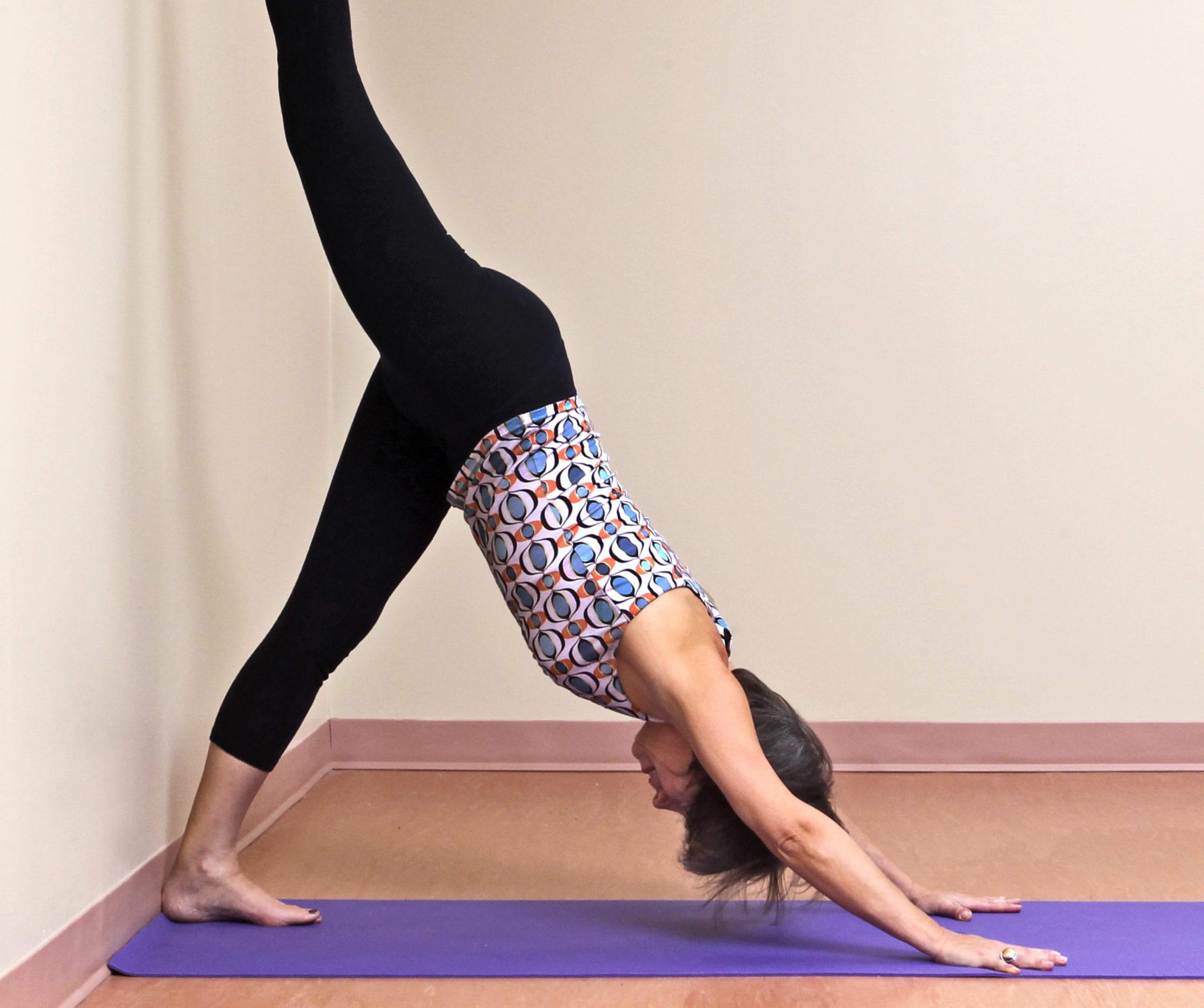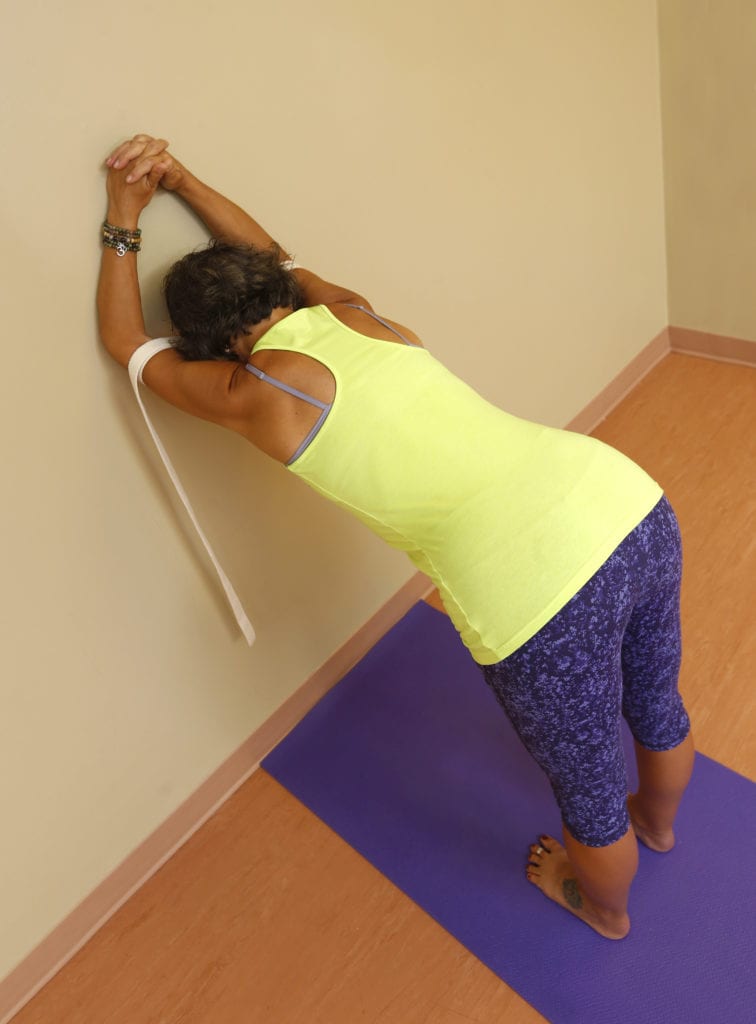When life throws you for a loop, just turn things around
Today’s rapidly changing environment guarantees we run the risk of having our personal world turned upside down. At any moment, a life-changing event can enter our sphere, flinging us into the unknown.
This is where Sirsasana (Headstand) and other upside-down poses (Inversions) allow us to experiment with unfamiliar feelings and fear arising from disorientation. To move beyond our fear of the unknown, we learn to lean into these feelings rather than avoid them.
In fact, Sirsasana is so effective in freeing us from fear and providing a multitude of other mental and physical benefits that yogis refer to it as the “King of Asanas.” Reversing the actions of gravity and directing blood flow to the skull and brain brings with it the opportunity to focus our awareness on balance and alignment. Mindful awareness of ourselves in the present moment is a large part of what it means to practise yoga.
As you ponder whether you will try Sirsasana, ask yourself which of the benefits below are welcome in your life:
- Nourishes brain and memory power. Thinking, remembering and analyzing are improved, thus enhancing our ability to stay focused.
- Prevents headaches, migraines and anxiety. Serenity and inner calm are induced and stress is relieved. (Note: do not do Sirsasana while experiencing any type of headache.)
- Rectifies glandular and nervous system functioning. Revitalizes the pituitary and pineal glands, thus helping to increase vitality and combat diabetes and fatigue.
- Improves efficiency in prostate, menstrual and menopausal functioning. Need we say more about the improvements to your sex life?
- Balances metabolic functioning. Acts directly on the thyroid and digestive tract.
- Strengthens the “organs of the face.” Eyesight, hearing, smell and taste are all stimulated and nourished, including the condition of our facial skin.
- Increases red blood cell formation and blood circulation in the scalp. Hair strength and growth stimulated.
- Relieves pressure on blood vessels. Varicose veins and piles are alleviated.
- Feeds and strengthens the lungs. Colds, coughs and tonsillitis are resisted.
- Improves core and upper body strength. Shoulders, arms and back are strengthened, while core muscles balance the body’s weight.
To build a healthy Sirsasana, approach your practice of this pose safely. We recommend to not try the pose for the first time without the guidance of a teacher. Your cervical vertebrae are small and fragile, which means you need to build the strength in your shoulders and arms in order to lift your body weight off your neck. Even though your head and arms are the foundation of the pose — that which grounds you to the Earth — the majority of lifting and balancing are done by the arms, shoulders, back and core. The head essentially rests on the ground. For those of you with neck, shoulder or back issues, stay with the headless variations of Sirsasana until you are healed. It is also recommended to avoid Sirsasana during pregnancy and menses.
Practising the preparatory poses and actions illustrated below, as well as other strength-building poses, will help you gain the confidence to lift up and take flight. Once our physical strength is sufficient, often the only thing holding us back is fear. To move from fear to freedom, have a teacher spot you. Asking for support is a good idea and may quell some of the discomfort. Ultimately, you are the only one who can discern if your fear of being upside down is irrational or a warning sign that you do not yet have the capacity required for the pose.
For beginner practitioners, be sure to move through the following poses in sequence. Spend as much time as you need in each pose before attempting the next. Each subsequent pose increases the level of difficulty and strength required.
Action: With your Sirsasana arms into the wall or the mat, find the pose’s foundation — your forearms and baby-finger sides of your palms. Press down evenly from your elbows through to the outer edge of your hands while keeping your inner wrists stacked over your outer wrists. Once in your variation of Sirsasana, lengthen down from your tailbone and out through your legs and heels.
For more advanced practitioners, also lengthen from your elbows up your upper arms into your shoulders and shoulder blades; lengthening them toward your tailbone. This will help support the lift of your pelvis away from your torso.
WALL STRETCH with SIRSASANA ARMS (with headstand arms)
Interlace your fingers and tuck your bottom baby finger in front of its counterpart. Place your forearms and outer palms onto the wall with your hands at eye level. Find the action in the arms as you step back and fold at your hip creases. Now find the action in the tailbone/pelvis. (Note: if your elbows will not stay in line with your shoulders — that is, they splay outward — create a belt loop, shoulder-width distance apart, and place it on your upper arms just above your elbows. Try the pose again.) Stay in the pose for five to 10 breaths, then come out. Change the interlacing of your fingers and go back into the pose for another five to 10 breaths.

ADHO MUKHA SVANASANA with SIRSASANA ARMS (Downward-facing dog with headstand arms)
Start on forearms (elbows under the shoulders) and knees in table-top position. Interlace your fingers, tucking in your bottom baby finger. As you press into your forearms and outer palms, come into this variation of Adho Mukha Svanasana. Your head remains off the floor. Find the actions in the arms and tailbone/pelvis. Again, use a belt around the forearms if the elbows splay outward. Stay in the pose for five to 10 breaths then come down. Change the interlacing of the fingers and go back up for another five to 10 breaths.
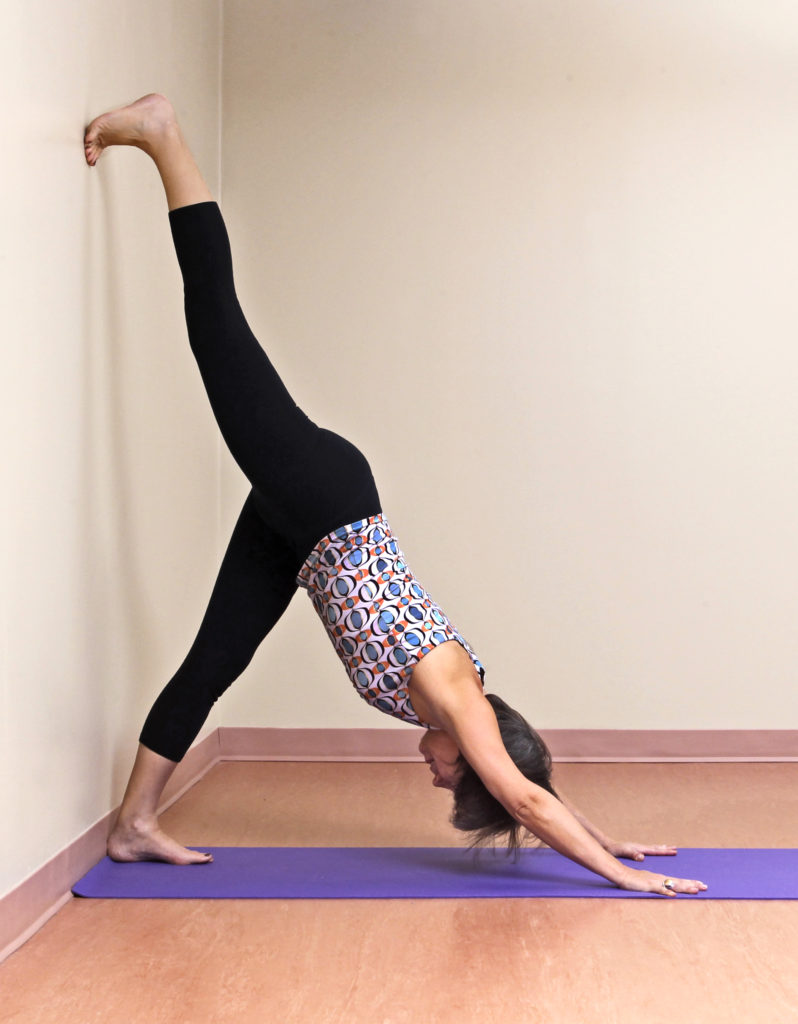
EKA PADA ADHO MUKHA SVANASANA (One-legged downward-facing dog pose)
Start in table-top position with your toes grazing the wall (a slightly shorter setup than your usual Adho Mukha Svanasana). Lift up into Adho Mukha Svanasana. Rest your heels on the wall if they do not reach the floor. Keep an even press into your palms as you lift one leg up the wall, and press the toe mounds of your lifted foot into the wall while you extend out the raised heel. Complete the arms and tailbone/pelvis actions. Hold for a few breaths and then repeat on other side. Rest in Balasana (Child pose), and then repeat the pose with your arms in Sirsasana. The head remains off the mat. Remember to complete the actions for the arms and tailbone/pelvis.

SIRSASANA — HEADLESS VARIATION (Headless headstand)
Once again, from Adho Mukha Svanasana, come into this headless variation with your arms in Sirsasana. Lift one leg up the wall. Stabilize by completing the actions and then lift the other leg. Complete the actions one more time. Keep your head off the floor. Hold for five to 10 breaths then come down, and rest in Balasana (Child pose). Change the interlacing of your fingers and go back up for another five to 10 breaths. Be sure to rest as needed.
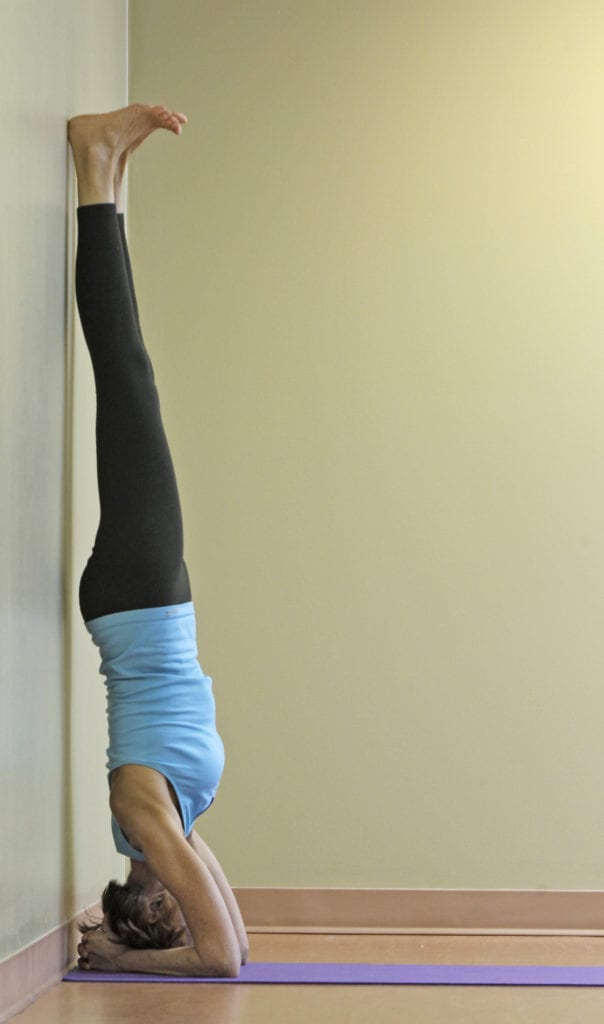
SIRSASANA wall-supported (Headstand against the wall)
Facing the wall, come into Adho Mukha Svanasana with your arms in Sirsasana. Either keep your head off the floor or nestle the back of your head into the cup of your hands with the space just in front of your crown onto the floor. (Note: if you are unable to hold a headless headstand against the wall for one to two minutes, then DO NOT release your head to the floor. The weight of your body will be too much for your cervical spine to bear.) Once you are in Adho Mukha Svanasana, walk your feet toward your elbows, bend your knees and lift your feet off the floor. If you are able to balance with your knees bent, then begin to straighten your legs upward and rest your heels at the wall. Complete the action in the arms and tailbone/pelvis. If your head is off the floor, build the amount of time you hold the pose from 10 breaths to two minutes. If your head is on the floor, hold for five to 15 breaths. Come down and rest in Balasana.
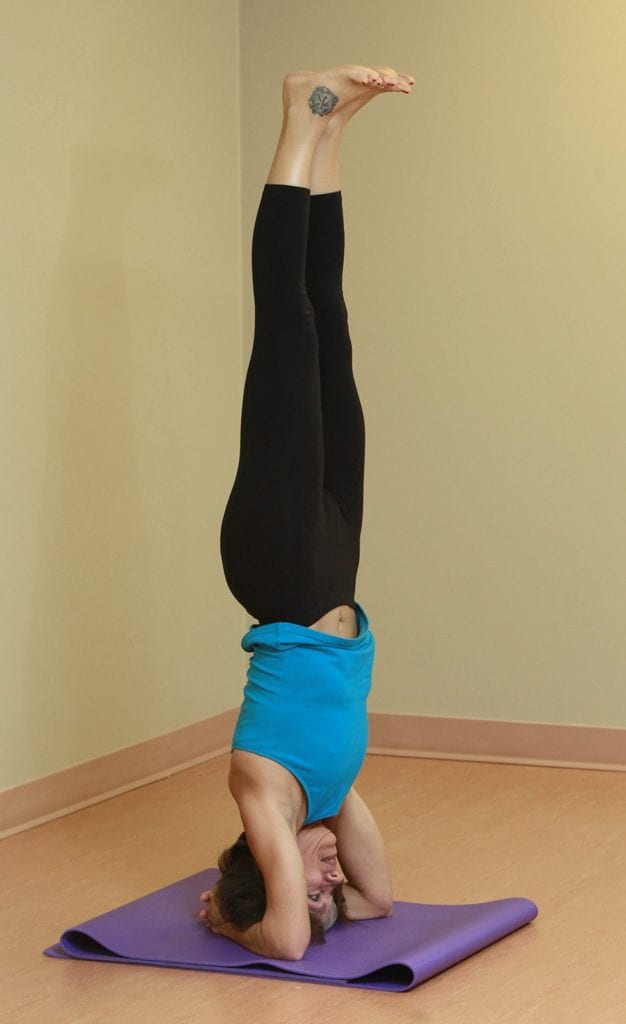
SIRSASANA (Headstand pose)
Place your folded mat away from the wall and then follow the instructions for the previous pose. Your head rests on the floor for the full pose. Complete the actions in the arms and tailbone/pelvis. Begin with shorter holds (30 seconds to one minute), particularly if you are practising Headstand less than three to five times a week.

SALAMBA SIRSASANA with Two Chairs (Supported headstand pose)
This is a great variation for releasing tension in the neck and creating space in the cervical vertebrae. Place two chairs, on a mat, with the seats slightly less than the head-width apart. From a crouching stance, guide your neck between the chairs and place your shoulders on the centre of the chair seats (use padding if needed). Gently kick or lift your legs — one or both at a time — up to the wall. Straighten your legs and rest your heels into the wall. Begin with short holds (10 breaths to one minute), especially if you are practising Headstand less than three to five times a week.
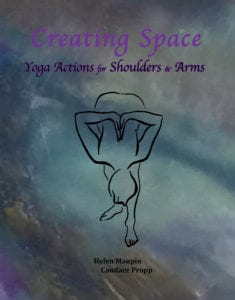 Winnipeggers Helen Maupin (righttojoy.com) and Candace Propp (natureofcontentment.ca) are 500-hour certified yoga teachers and authors of the Creating Space: Yoga Actions book series. To purchase these print or ebooks, visit here. For yoga teacher training with them and Stacy Schroder, go to sereneyogastudio.com.
Winnipeggers Helen Maupin (righttojoy.com) and Candace Propp (natureofcontentment.ca) are 500-hour certified yoga teachers and authors of the Creating Space: Yoga Actions book series. To purchase these print or ebooks, visit here. For yoga teacher training with them and Stacy Schroder, go to sereneyogastudio.com.

